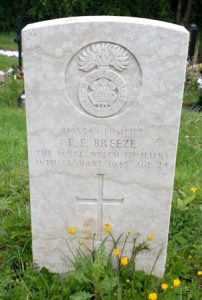Llandrinio is a small village and community in Montgomeryshire, close to the Wales-England border, and is situated on the B4393 road which travels from the village of Ford, Shropshire to Lake Vyrnwy. The River Severn and Offa’s Dyke both run through the village. The men of the village who fell during the Great War are commemorated on a war memorial, in the form of an obelisk, which is situated to the right of the Lych gate of the Parish Church, which is dedicated to Saints Trinio, Peter and Paul. After the end of the Second World War, one further name was added to the memorial, to commemorate the sole man who fell in the latter conflict. The memorial was unveiled in November 1920.
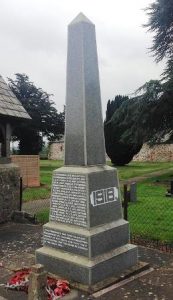
The Great War, 1914-1918
Ernest Stanley Brown, Private, 238049, Duke of Wellington’s (West Riding Regiment). Ernest was the son of Edward and Emma Brown, of Ashfield, Four Crosses. He worked as a farm labourer for his grandparents at Haughton, Llandrinio prior to the war. Ernest enlisted at Welshpool into the Montgomeryshire Yeomanry, and was posted to France during the spring of 1918, joining the 9th Battalion, Duke of Wellington’s (West Riding Regiment), which was attached to 52 Brigade, 17th (Northern) Division. During March 1918 the Division was on the Somme, and faced the German Spring Offensive of 21 March onwards, seeing heavy casualties as it was forced to withdraw towards La Boiselle and Fricourt, before the Germans were stopped at Millencourt. Ernest would have joined the battalion here soon afterwards, as it was rebuilding. After a period out of the line to rest and rebuild, the Division moved to the southernmost sector of the Somme area, and fought at the Battle of Amiens on 8 August 1918, a day which saw the war swing in the favour of the Allies. The Allies then advanced on the Somme from 21 August onwards, and the Division took part in this great offensive, fighting at the Battle of Bapaume on 31 August, before advancing towards the Hindenburg Line, fighting at the Battle of Havrincourt on 12 September and the Battle of Épehy on 18 September. At the beginning of October, the mighty Hindenburg Line was broken, and the 17th Division swept towards Cambrai, fighting at the Battle of Cambrai on 8 October, and then north-east through northern France, towards the old Battlefields of Mons and Le Cateau, during the Pursuit to the Selle and the Battle of the Selle during the middle of October. On 17 October Ernest’s battalion took up positions near the River Selle at Inchy, and suffered several days of gas shelling by the Germans. Ernest was killed in action just before the battalion was relieved on 19 October 1918. The 24-year-old is buried in Selridge British Cemetery, Montay, France.
Edgar Wynn Jones, Private, 187082, Canadian Infantry. Edgar was born in 1895, the son of Richard Parry Jones and Catherine Ellis Jones, of Orchard House, Llandrinio. Edgar emigrated to Lakefield, Minnesota, USA in 1912, where he found work as a miner. He travelled to Canada after the outbreak of war and on 12 November 1915 enlisted into the 90th Battalion, Canadian Infantry at Winnipeg. Edgar embarked for England at Halifax aboard the RMS Olympic, and disembarked at Liverpool on 8 June 1916, entraining for Salisbury Plain to join the Canadian camp. On 27 August 1916 he was posted to France, and joined the 1st Battalion, Canadian Mounted Rifles, which was attached to the 8th Infantry Brigade, 3rd Canadian Division. The battalion had spent several months at Ypres, since landing in France in September 1915, and had seen heavy fighting at the Battle of Mount Sorrel in June 1916, before moving to the Somme early in September. By 15 September 1916 the 3rd Canadian Division relieved the Australians near Pozieres, and the 1st Canadian Mounted Rifles attacked the strongly defended Mouquet Farm, whilst other Canadian units assaulted Courcelette. Edgar’s battalion suffered heavy casualties during the attack, and was relieved that night, moving to billets in Albert. The battalion then moved to the rest area at Warloy-Baillon before returning into the front line on 27 September. A large party of men was then despatched to dig a new trench, but came under heavy machine-gun and artillery fire. Edgar was killed in action at Hessian Trench on 28 September 1917, while the battalion was hard at work. The 21-year-old is buried in Courcelette British Cemetery, France.
George Albert Jones, Private, 67600, Cheshire Regiment. George was the son of Thomas and Elizabeth Jones, of Trederwen, Bytake, Llandrinio. He worked as a waggoner prior to enlisting into the Montgomeryshire Yeomanry at Welshpool on 21 March 1917, and was posted to the 60th Training Reserve Battalion at Kinmel Park, Bodelwyddan for training. George embarked for France at Southampton on 31 March 1918, and joined the Infantry Base Depot at Rouen. On 9 April 1918 George was posted to the 15th Battalion, Cheshire Regiment, joining C Company. The battalion was attached to 105 Brigade, 35th Division, and had been at Ypres until entraining for the Somme on 23 March 1918, to reinforce the battered Divisions which had been taking part in the desperate fighting which followed the launching of the German Spring offensive of 21 March. The Division took up positions in Corps Reserve astride the Albert to Amiens road, and George joined the battalion at Bouzincourt on 10 April. The battalion then took over positions east of Martinsart, and held the line on Bouzincourt Ridge, to the right of the 38th (Welsh) Division, which had just moved south from Armentieres. At the end of June, the 35th Division withdrew from the Somme and began moving north, to the Locre sector, in Flanders. During August the Division moved into the St. Jan Cappel sector, and prepared to join the great Allied offensive. To the south the Allies launched a great offensive on 21 August, and began their drive towards the Hindenburg Line. It was five weeks later, on 28 September, that the Allies attacked in Flanders. The 35th Division launched its part of the great advance from its positions at Les Trois Rois, and by the following day had reached Zandvoorde. The advance continued over the coming weeks, with the infantry battalions of the division taking turns to lead the assault. George was wounded during an assault along the Menin Road early in October, and was evacuated to the 62nd Casualty Clearing Station, where he died of his wounds on 15 October 1918. The 20-year-old was buried in Lijssenthoek Military Cemetery, Belgium.
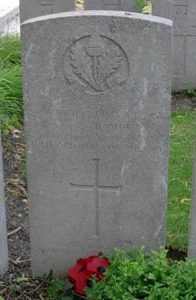
John Jones, Private, 39167, South Wales Borderers. John was the son of John and Susan Jane Jones, of Rheteskin, Llandrinio. He worked as a farm labourer prior to enlisting into the Montgomeryshire Yeomanry at Welshpool. After completing his training, John was drafted to France early in 1917, and was posted to the 1st Battalion, South Wales Borderers. The battalion was attached to 3 Brigade, 1st Division, and had followed the German retreat to the Hindenburg Line in early 1917. The Division was then briefed for an operation on the Flanders Coast, and moved there during the summer of 1917. Meanwhile, the Third Battle of Ypres, or the Passchendaele offensive, had been launched on 31 July, but failed to make the desired breakthrough, so the coastal operation was cancelled, and the 1st Division was sent to Ypres, taking part in the Second Battle of Passchendaele, the final attacks on the ridge itself. After spending the last winter of the war in the Ypres Salient, early in April the Division entrained for the Beuvry sector. The Allies were busy moving troops around, due to heavy losses suffered following the launching of the German Spring offensive on the Somme on 21 March 1918, and the fighting in that sector was still ongoing when the Germans launched the second phase of their offensive along the Lys Valley on 9 April. The men of the 1st Division quickly received news of the offensive, which stretched along a line running from Armentieres to the La Bassée Canal, and during the evening the Division moved forwards towards the line. Nothing of note occurred on the following day, as far as the 1st Division was concerned, and on 11 April 1918 the 1st SWB took over positions on the canal, to await the oncoming Germans. John was killed in action soon after the move that day. The 24-year-old was buried in Brown’s Road Military Cemetery, Festubert, France.
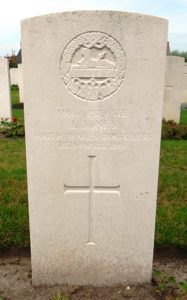
Cecil Hallowes Lewis, Major, Royal Army Service Corps. Cecil was born at Bolsover, Derbyshire on 9 March 1869, the son of Reverend David Phillips, Rector of Llandrinio, and his wife Louisa Lewis (nee Hallowes). He was educated at Christ College, Brecon from 1881, and became a renowned sportsman, playing cricket for the College XI. After leaving school Cecil joined the Army, receiving a commission as Second Lieutenant into the South Wales Borderers in 1888, and three years later transferred to the Dorsetshire Regiment. After his promotion to Lieutenant, Cecil transferred to the Army Service Corps and was attached to the Uganda Rifles, serving in East Africa. He remained in Africa over the coming years, gaining the medal for the Nandi Expedition in 1900, and by 1904 had been promoted to Major. When the Great War erupted, Cecil was serving with the 1st Division Train, Army Service Corps, and landed in France with the unit on 16 August 1914. His units’ main duties involved the supply of munitions, food, water and other essential items to front line troops. The unit moved to Mons with the 1st Division, and following the German invasion of Belgium, took part in the retreat from Mons to the Marne, before stopping the German drive on Paris, during the Battles of the Marne and the Aisne. The 1st Division then moved to Flanders with the BEF, and took part in the gallant defence of Ypres, during the Germans attempt to capture the city and advance to the Channel coast, helping stop the Germans during a gallant stand at Gheluvelt. The Division wintered in Flanders, and took part in the Battle of Aubers Ridge the following Spring. Cecil was wounded whilst the 1st Division was in the Bethune area, and was evacuated to hospital at Rouen, where he died of his wounds on 28 May 1915. The 46-year-old is buried in St. Sever Cemetery, Rouen, France. Cecil is not commemorated on the Llandrinio war memorial, but is commemorated at Christ’s College, Brecon.
Robert John Moorhouse, Private, 1043, Royal Welsh Fusiliers. Robert was born in 1895, the son of Thomas Moorhouse and Eliza Julia Moorhouse (nee Thomas), of York Cottage, Llandrinio. He enlisted into the 7th Battalion, Royal Welsh Fusiliers at some time prior to the war, and served with C Company. The battalion was a Territorial unit, which mobilised for war at Newtown in August 1914, as part of North Wales Brigade, Welsh Division and moved to Conway until the end of the month, before moving to Northampton. In December the Division moved to Cambridge and then in May 1915 to Bedford, where the Division was numbered and the formation became 158 Brigade, 53rd (Welsh) Division. On 19 July 1915 the entire Division sailed from Devonport for Imbros and on 9 August 1915 landed at Suvla Bay. The infantry moved off the beaches into the bush, but due to a lack of maps and no knowledge of the terrain, many of the units became disorientated, and the situation became chaotic. Robert was killed in action during heavy fighting on the following day, 10 August 1915. The 20-year-old has no known grave and is commemorated on the Helles Memorial, Gallipoli. His brother, Stuart, had been killed at sea soon after the outbreak of war.
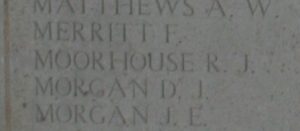
Stuart Ford Moorhouse, Ordinary Seaman, SS/4294, Royal Navy. Stuart was born on 28 February 1894, the son of Thomas Moorhouse and Eliza Julia Moorhouse (nee Thomas), of York Cottage, Llandrinio. He worked as a Butcher’s Assistant prior to enlisting into the Royal Navy on 16 May 1913, signing up for five years’ service, and was posted to HMS Victory I at Portsmouth for training. On 13 July 1913 Stuart was posted aboard the battleship HMS Bulwark, which had just received a refit at Portsmouth. Stuart then participated in the annual fleet manoeuvres aboard Bulwark in August, which returned to Spithead on 30 October, remaining there for the rest of the year. On 22 May 1914 Bulwark began her annual refit at Chatham, and returned to duty on 9 July. The Royal Navy was mobilised on 15 July, with war now no longer in doubt, and Bulwark took part in exercises at Spithead, before moving to Portland to join the 5th Battle Squadron of the Second Fleet. The Fleet escorted the BEF to Flanders in August 1914, and the 5th Battle Squadron returned to Portland briefly before being sent to Sheerness. On the morning of 26 November 1914, Bulwark was at anchor off Sheerness, in the River Medway, when a massive internal explosion ripped her apart, and she sank at her moorings, with the loss of 741 lives. Stuart was just 20-years-old when he was killed that day, and is commemorated on the Portsmouth Naval Memorial, Hampshire. His brother, Robert, was killed at Gallipoli in 1915.
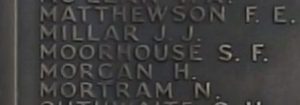
John Everett Owen, Private, 202966, Royal Welsh Fusiliers. John was the son of William Owen and Mary Jane Owen (nee Jones), of Ivy Cottage, Llandrinio. His father ran The Bell, at Morda. John worked as a gardener prior to enlisting into the 3/1st Battalion, Montgomeryshire Yeomanry at Welshpool on 15 February 1916. He was posted to Park Hall Camp, Oswestry for training, and on 8 December 1916 embarked at Southampton for France. John joined the Infantry Base Depot at Rouen, before being posted to the 1/4th Battalion, Royal Welsh Fusiliers on 9 January 1917. The battalion was at The Pioneer Camp at Ypres, and was the Pioneer Battalion to the 47th (2nd London) Division. The battalion was hard at work, supplying working parties to the treacherous Bluff and Railway Dugouts positions at Ypres at the time. John had only been with the battalion for three weeks when he was wounded on 5 February, and was evacuated through the chain of the 6th Field Ambulance, 2nd Canadian Casualty Clearing Station and Boulogne Hospital, before being taken back to England aboard the Hospital Ship St. David on 26 February. After his recovery he embarked for France at Southampton again on 12 September 1917, re-joining No 5 Infantry Base Depot at Rouen, before being posted to the 19th Battalion, Royal Welsh Fusiliers on 24 September 1917. The battalion was attached to 119 Brigade, 40th (Bantam) Division, and was in the line south of Gouzeaucourt, facing the Hindenburg Line. Just days later the 19th RWF was relieved, moving into reserve at Doingt with the rest of 119 Brigade. The entire Division then moved into the rear area around Simencourt, where it undertook a scheme of training, in preparation for the forthcoming Battle of Cambrai. By 22 November the Division had taken up positions in Anneux, on the Arras to Cambrai road, and on 23 November 1917 launched its famous assault on Bourlon Wood, seeing heavy fighting over the coming days until being relieved on the night of 25-26 November, and moving into reserve. The Division then moved to the Bullecourt sector, and began work on trench consolidation and repairs. John was killed in action here during a routine spell in the line on 24 December 1917. The 26-year-old is buried in Croisilles Railway Cemetery, France.
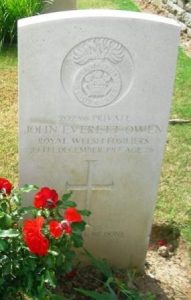
Wallace James Pritchard, Private, 41142, Manchester Regiment. Wallace was the son of Richard and Alice Pritchard, of Llandrinio. He lived in Stafford and had married Susan Owen there just prior to the outbreak of war. Wallace enlisted in Stafford into the 10th Battalion, North Staffordshire Regiment, but in the summer of 1916 was transferred to the 11th Battalion, Manchester Regiment. The battalion had moved to France from Egypt in July 1916, following service at Gallipoli, and was attached to 34 Brigade, 11th (Northern) Division. The Division moved to the Somme, and took part in the Battle of Flers-Courcelette during the Somme Offensive, before spending the winter on the Ancre. The Division followed the German withdrawal to the Hindenburg Line in March 1917, reaching the Morchies-Beaumetz area, but was relieved in May, and entrained for Bailleul before taking over positions near Locre. On 7 June 1917 the Division took part in the great assault on Messines Ridge, which was preceded by the blowing of a series of huge underground mines, and remained in the same area over the coming weeks. The Division was at Elverdinghe, in support of the 38th (Welsh) Division, when the Passchendaele offensive was launched on 31 July 1917 and on 15 August moved into the line facing Langemarck, taking part in the attempts to capture the village. After a brief rest the Division moved back into the line, and saw further fighting during the attacks on the Passchendaele Ridge. By 3 October the 11th Manchester’s had moved back into the line on the Poelcapelle to St. Julien road, to carry on the offensive. Wallace was badly wounded during an assault on 4 October, and was evacuated to a Casualty Clearing Station at Proven, where he died of his wounds on 6 October 1917. The 29-year-old is buried in Dozinghem Military Cemetery, Belgium.
Arthur Roberts, Lance Corporal, 39965, Welsh Regiment. Arthur was born in Llandegley, Radnorshire in 1893, the son of Arthur and Elizabeth Roberts. By 1911 his parents had moved to Rhos Nursery, Llandrinio, where Arthur was working as a Hawker. By 1914 he was residing at Haverfordwest with his wife, Isabelle Roberts (nee Everson), and their son, Arthur, was born there on 18 March 1916. Arthur enlisted into the Welsh Regiment at Haverfordwest, and his wife moved to Rhos-Common, Four Crosses with their son. Arthur was posted to France in the summer of 1916, joining the 2nd Battalion, Welsh Regiment, which was attached to 3 Brigade, 1st Division. The Division had taken part in the Battle of Loos the previous year, and had remained in the Loos sector over the winter, before moving south to the Somme at the beginning of July 1916 to join the Somme offensive. By 16 July the Division had taken up positions at Bazentin-le-Petit Wood, and saw heavy fighting over the coming days, during the Battle of Bazentin Ridge, and the ensuing Battle of Pozieres. The Division remained on the Somme throughout the rest of the offensive, and followed the German retreat to the Hindenburg Line in March 1917. In June the Division moved to positions near Dickebusch, where it received further orders to move to the Channel coast, to prepare for a potential offensive, reaching Coxyde, on the Belgian coast, by 5 July. In the meantime, the Passchendaele offensive opened on 31 July, but despite initial gains, failed to make the breakthrough that had been hoped for, so the 1st Division was transferred to Ypres at the beginning of November, and took over the line on Passchendaele Ridge. Arthur was killed in action here soon afterwards by artillery fire, on 9 November 1917. The 24-year-old was originally buried on the battlefield, but after the war his grave was discovered and his body was identified by his ID disc, before being re-interred in Tyne Cot Military Cemetery, Belgium.
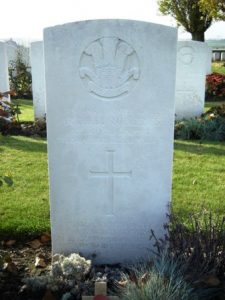
Herbert Roberts, Private, 31119, South Lancashire Regiment. Herbert was the son of John and Eliza Margaret Roberts, of Haim Wood, Llandrinio. He worked as a gardener at Hardwicke Hall, Ellesmere prior to enlisting into the 3/4th Battalion, King’s Shropshire Light Infantry at Shrewsbury on 4 October 1915. Upon completing his training, Herbert embarked at Southampton for France on 7 September 1916, and joined the 4th Infantry Base Depot at Rouen. On 16 September 1916 Herbert was transferred to the 4th Battalion, South Lancashire Regiment, before being posted to the 8th Battalion, South Lancashire Regiment, joining the battalion in billets at Cramont on 17 September as part of a draft of 85 men of the KSLI. The battalion was attached to 75 Brigade, 25th Division, and had seen heavy fighting on the Somme over the previous weeks. After a brief rest, at the end of September the 8th South Lancs moved back into the line at Hessian Trench and the Zollern Redoubt, and supported an attack by the Canadians on Regina Trench. The Division saw further fighting at Regina Trench during October, but at the end of the month was relieved, before entraining for Bailleul, taking over the line in the Ploegsteert Wood sector. The Division spent the winter here, its infantry battalions carrying out the usual system of trench rotation, usually four days in the front line, four in support and four in reserve. On the night of 18 February 1917, the 8th South Lancs sent out a raiding party to attack the German positions SE of Ploegsteert Wood, but in doing so suffered the loss of five men killed, 35 wounded, and three men missing. Herbert was one of the three men reported as missing on 18 February 1917, and was afterwards adjudged to have been killed in action on that date. The 20-year-old has no known grave and is commemorated on the Ploegsteert Memorial, Belgium.
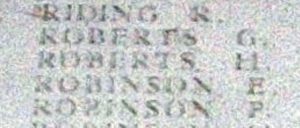
Herbert Henry Roberts, Private, 355407, Royal Welsh Fusiliers. Herbert was the son of Thomas Fox Roberts and Sarah Jane Roberts, of Holly House, Llandrinio. He enlisted into the 3/1st Battalion, Montgomeryshire Yeomanry at Welshpool on 3 June 1915, and was posted to Park Hall Camp, Oswestry for training, before joining the 1/1st Battalion, Montgomeryshire Yeomanry ay Thetford, where it was attached to the 1st Mounted Division. On 4 March 1916 the 1st Mounted Division sailed for Egypt to join the EEF. On 4 March 1917 the battalion merged with the Welsh Horse Yeomanry to form the 25th (Montgomery & Welsh Horse Yeomanry) Battalion, Royal Welsh Fusiliers, as part of the newly formed 231 Brigade, 74th (Yeomanry) Division. The Division assembled in Egypt as part of the EEF, before crossing the Suez Canal into the Sinai, and saw its first major action during the Second Battle of Gaza. The battle was a failure, and the EEF was re-organised under a new commander, Sir Edmund Allenby, before launching the Third Battle of Gaza on the night of 31 October 1917. This assault was launched along a winder front, running from Gaza to Beersheba, and this time the EEF prevailed, opening the door to Jerusalem. Herbert had been killed in action during the opening day of the battle, on 31 October 1917. The 22-year-old is buried in Beersheba War Cemetery, Israel.
Frederick Gomer Southerton, Private, 3303, King’s Shropshire Light Infantry. Frederick, known as Gomer, was the son of Samuel Southerton and Margaret Southerton (nee Edwards), of Towers Cottage, Llandrinio. He worked as a domestic servant prior to the war. Gomer enlisted at Welshpool into the Montgomeryshire Yeomanry, and was sent to Park Hall Camp, Oswestry for training. Gomer was probably posted to Egypt with the 1/1st Battalion, Montgomeryshire Yeomanry in March 1916, as he was later transferred to the 10th Battalion, King’s Shropshire Light Infantry. The battalion formed at Cairo on 2 March 1917 from two dismounted Yeomanry regiments, joining 231 Brigade, 74th (Yeomanry) Division, and saw its first major action during the Second Battle of Gaza on 17 April. The battle was a failure, and the EEF was re-organised under a new commander, Sir Edmund Allenby, before launching the Third Battle of Gaza on the night of 31 October 1917. This assault was launched along a winder front, running from Gaza to Beersheba, and this time the EEF prevailed, opening the door to Jerusalem. The Division then took part in the drive north into Syria, but as a result of the heavy losses suffered in France, following the launching of the three German Spring offensives from 21 March 1918, was sent to France, landing in Marseilles on 7 May 1918. The Division underwent a system of training, to prepare it for the vastly different conditions on the Western Front, before taking over a section of the front in the St. Floris Sector. In September the Division moved south to the Somme sector, to join the great Allied offensive towards the Hindenburg Line, and on 18 September took part in an assault on positions near Lempire and Ronssoy, which formed part of the outer defensive line for the Hindenburg Line. After suffering heavy casualties, especially around Orchard Post and Gillemont Farm, the Division then attacked the Quadrilateral defences, suffering heavily again before being relieved on 24 September and entrained at Péronne for northern France once more. The Division then took part in the Advance in Flanders, and by the end of October had reached Marquion, launching an assault from there on 2 November, before establishing a new front line. Gomer was killed in action here on what the war diary called an ‘uneventful day’ on 5 November 1918, less than a week before the Armistice. The 23-year-old is buried in Lamain Communal Cemetery, Belgium.
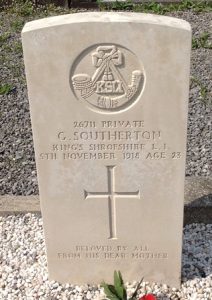
John Frederick Theodore, Private, 355276, Royal Welsh Fusiliers. John was the son of John Theodore and Elizabeth Theodore (nee Jones), of Bagleys Lane, Llandinam. He worked as a waggoner at The Hayes, Alberbury prior to enlisting into the Montgomeryshire Yeomanry at Llandysilio on 10 September 1914, and was posted to the Depot at Welshpool. The Montgomeryshire Yeomanry had been mobilised at Welshpool at the outbreak of war, as part of the South Wales Mounted Brigade, before moving via Hereford to Thetford, to join the 1st Mounted Division. On 4 March 1916 the 1st Mounted Division sailed for Egypt to join the EEF. On 4 March 1917 the battalion merged with the Welsh Horse Yeomanry to form the 25th (Montgomery & Welsh Horse Yeomanry) Battalion, Royal Welsh Fusiliers, as part of the newly formed 231 Brigade, 74th (Yeomanry) Division. The Division assembled in Egypt as part of the EEF, before crossing the Suez Canal into the Sinai, and saw its first major action during the Second Battle of Gaza. The battle was a failure, and the EEF was re-organised under a new commander, Sir Edmund Allenby, before launching the Third Battle of Gaza on the night of 31 October 1917. This assault was launched along a winder front, running from Gaza to Beersheba, and this time the EEF prevailed, opening the door to Jerusalem. The Division then took part in the drive north into Syria, but as a result of the heavy losses suffered in France, following the launching of the three German Spring offensives from 21 March 1918, was sent to France, landing in Marseilles on 7 May 1918. The Division underwent a system of training, to prepare it for the vastly different conditions on the Western Front, before taking over a section of the front in the St. Floris Sector. In September the Division moved south to the Somme sector, to join the great Allied offensive towards the Hindenburg Line, and on 18 September took part in an assault on positions near Lempire and Ronssoy, which formed part of the outer defensive line for the Hindenburg Line. John was killed in action during the fighting that day. The 28-year-old has no known grave and is commemorated on the Vis-en-Artois Memorial, Haucourt, France.
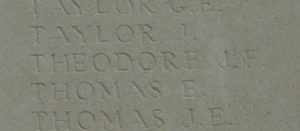
Eric Cecil Wentworth Vernon, Private, 15270, Coldstream Guards. Eric was born on 22 November 1896, the son of Cecil Charles William Vernon and Isabel Charlotte Leane Vernon (nee Flick), of The Firs, Llandrinio. He was educated at Welshpool Grammar School prior to enlisting into the Royal Navy on 27 November 1914, and was posted to HMS Vivid I at Portsmouth for training. His father was obviously not happy that his son had enlisted whilst still at school, so he purchased his release from the Royal Navy on 13 July 1915, and Eric was forced to return home. Undeterred, he enlisted at Shrewsbury into the Coldstream Guards soon after his release, and was posted to France on 19 October 1915, joining the 3rd Battalion, Coldstream Guards, which was by then attached to the newly formed 1st Guards Brigade, Guards Division. The Division had suffered severe casualties during the Battle of Loos from 25 September, especially during its assault on Hill 70, but remained in the Loos sector, taking part in the Actions of the Hohenzollern Redoubt. After spending the winter in the Loos sector, the Guards moved to Calais to rest before taking over a section of line at Potijze, in the Ypres Salient. In July 1916 the Division moved to the Somme, where it fought at the Battle of Flers-Courcelette, the first time that tanks were used in action, and then took part in the Battle of Morval. The 3rd Coldstream’s moved into the front line near Ginchy on 21 September, facing the village of Lesboeufs, and spent three days in the line under hostile shellfire before moving into support three days later for a brief rest. On 25 September the battalion moved forwards again, in preparation to assault the village, launching its attack that day, before digging into its newly captured positions. Eric was killed in action on the following day, 26 September 1916, when the battalion was still busy consolidating its gains, under almost incessant shellfire. The 19-year-old has no known grave and is commemorated on the Thiepval Memorial, France.
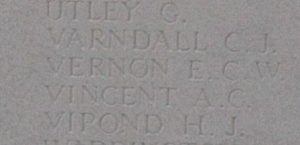
Lewis Stuart Whittingham, Second Lieutenant, Royal Inniskilling Fusiliers. Lewis was born in 1882, the son of Lewis Browne Whittingham and Mary Augusta Whittingham (nee Stuart), of New Hall, Llandrinio. By 1911 he was living as a Boarder at Aston Munslow, Craven Arms, where he worked as Land Agent for Millichope Park Estates. By then his parents had moved to Killarney, 26, Butterton Road, Rhyl. Lewis became an Officer Cadet soon after the outbreak of war, and on 5 September was commissioned as a Second Lieutenant into the 7th Battalion, Royal Welsh Fusiliers. The battalion was a Territorial Army unit, with a reserve battalion based at Park Hall, Oswestry, and Lewis probably trained there before embarking for France on 25 October 1916, joining the 1st Battalion, Royal Inniskilling Fusiliers. The battalion was attached to 87 Brigade, 29th Division, and had seen service at Gallipoli before moving to France and suffering heavy casualties during the opening of the Somme offensive. The Division had then moved to Ypres, taking over positions on the Canal Bank near Boesinghe to rebuild, before moving back to the Somme, reaching Fricourt by 14 October and taking over the line at Gueudecourt, which is where Lewis joined the battalion. The Division wintered on the Somme, holding the line near Combles. On 26 February 1917 the Inniskilling’s moved back into the line at Combles, to begin a routine spell in the trenches, and the men began work on improving and consolidating their positions. Lewis was killed in action here two days later, on 28 February 1917. The 35-year-old was originally buried on the battlefield, and his grave was marked with a cross, but after the war his grave was exhumed, and he was re-interred in Sailly-Saillisel British Cemetery, France.
John Lewis Williams, Private, 50470, South Lancashire Regiment. John was the son of William and Jane Williams, of Lower House, Haughton, Llandrinio. He enlisted into the army at Welshpool, and after completing his training, was posted to France in the summer of 1917, joining the 7th Battalion, South Lancashire Regiment. The battalion was near Messines, attached to 57 Brigade, 19th (Western) Division, and had taken part in the Battle of Messines Ridge from 7 June 1917, suffering heavy casualties during a week of ferocious fighting. John probably joined the battalion at Weston Camp, Scherpenberg, where it was resting and rebuilding following the battle. The battalion then moved to Butterfly Farm Camp, where it supplied working parties to repair the Kemmel to Wytschaete Road over the coming weeks, before moving to Onraet Farm on 20 July. The main Passchendaele offensive, or Third Battle of Ypres, opened on 31 July 1917, and John’s battalion, now at Irish House, had moved into support trenches on the preceding night, to take part in another assault by the 19th Division, and saw heavy fighting during the opening day of the battle. A week later, the Division was relieved and moved into reserve to rest, before moving back into the line by 19 September, to prepare for another offensive, the Battle of the Menin Road. John was wounded during the opening offensive on 20 September, and was evacuated to hospital in Outtersteene, where he died of his wounds on 23 September 1917. The 19-year-old was buried in Outtersteene Communal Cemetery Extension, Bailleul, France. One of his brothers, William, had been accidentally killed in France just four months earlier.
William Edward Williams, Sapper, 69399, Royal Engineers. William was the son of William and Jane Williams, of Lower House, Haughton, Llandrinio. He served an apprenticeship as a carpenter with George Wynne, of Alberbury and had worked for him for a further two years prior to enlisting into the Royal Engineers at Shrewsbury on 1 March 1915, and was posted to the RE Depot at Chatham for training. He was then posted to the 76th Field Company, Royal Engineers, embarking for France with the Company on 9 August 1915. The Company joined the newly formed Guards Division, in the Loos sector, and saw its first major action during the Battle of Loos, when it was thrown into action on 26 September. A lot of William’s work at the time was in making scaling ladders, for the front-line troops to use to clamber out of the trenches, but as a carpenter his skills were also put to good use in constructing A-Frames for trenches, as well as other vital work in the newly captured Hohenzollern Redoubt. After spending the winter in the Loos sector, the Guards moved to Calais to rest before taking over a section of line at Potijze, in the Ypres Salient. In July 1916 the Division moved to the Somme, where it fought at the Battle of Flers-Courcelette, the first time that tanks were used in action, and then took part in the Battle of Morval, capturing Lesboeufs Village. The Division remained here for the winter, following up the German withdrawal to the Hindenburg Line in March 1917. By 19 May 1917 Williams’s company had moved to rest billets at Bonnay. On 24 May 1917 some men from the Scots Guards arrived to instruct a number of men of the 76th Field Company in grenade throwing. One of William’s comrades, Sapper Young, primed a grenade, and was in the act of throwing it when it exploded, blowing off his hand, and sending fragments flying, which caught William in the neck. William was taken to the 38th Casualty Clearing Station at Heilly for treatment, but died that same day as a result of his accidental wounds. The 23-year-old was buried in Heilly Station Cemetery, Mericourt-L’Abbe, France. One of his brothers, John, died of wounds in France four months later.
World War Two, 1939-1945
Ernest Ellis Breeze, Fusilier, 4195349, Royal Welch Fusiliers. Ernest was the son of William Breeze and Catherine Letitia Breeze (nee Lloyd), of Ark Cottage, Llanfyllin. Ernest enlisted into the 7th Battalion, Royal Welch Fusiliers following the outbreak of war. The battalion was a Territorial Army unit, attached to 158 Brigade, 53rd (Welsh) Division. The battalion was mobilised at the outbreak of war, when the Division moved to Northern Ireland to begin garrison duties. The Division then moved to Pembroke Dock, before moving again to the south of England, where it trained in readiness for the D-Day Landings. Ernest was home on leave early in 1944, and married Annis Jefferey, of Oldham at Llandinam, before re-joining his battalion. On 24 June 1944 the 7th RWF left England for Normandy, and landed at La Riviere near Ver Sur Mer. The Division then took part in heavy fighting over the coming weeks, as part of the effort to break-out of the Normandy beach-head, seeing heavy fighting at Évrecy, before starting the epic advance through Northern France into Belgium and Holland. On 15 September the Division forced the crossing of the Junction Canal North of Lommel, and continued to push westwards towards Elst, between Nijmegen and Arnhem, during Operation Market Garden. On 22 October the Division launched its famous assault on ‘s-Hertogenbosch, before continuing its advance to the German frontier. Between December 1944 and January 1945, the Division took part in the Battle of the Bulge, helping in the counter-attack which helped save the Americans, who were under heavy pressure, then after the German offensive was broken, took part in heavy fighting to enter the Rhineland. Ernest had been sent back to England at some time, either wounded or ill, and he died at Ashton, Lancashire on 16 January 1945. The 24-year-old is buried in Oldham (Greenacres) Cemetery, Lancashire.
